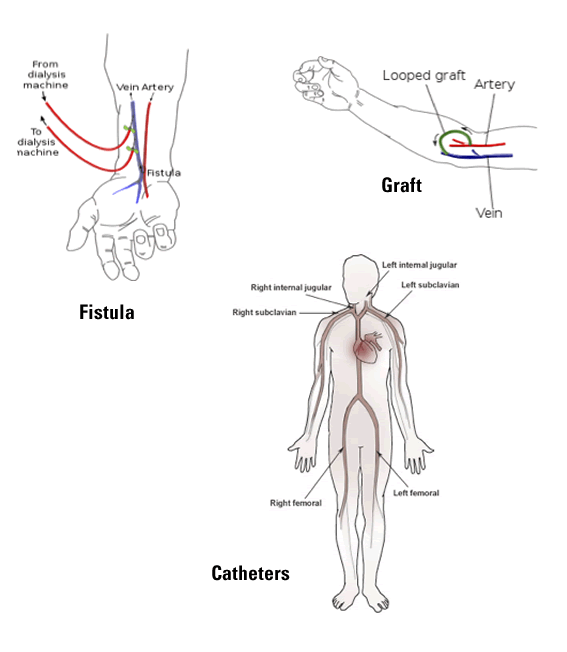In Center Dialysis
Dialysis is a process of cleaning wastes and extra fluid from the blood artificially. This job is normally done by the kidneys. If the kidneys fail, the blood must be cleaned artificially with special equipment. The two major forms of dialysis are hemodialysis and peritoneal dialysis.
Hemodialysis
Hemodialysis is a way to clean wastes and extra fluid from the blood using a machine. This helps to replace the work of the kidneys after they have failed. The blood is filtered outside of the body. Treatments are done in-center at a dialysis unit 3 times a week, and appointments are scheduled in advance. Hemodialysis is the most common kind of dialysis. A vascular access should be prepared weeks or months before you start dialysis. The early preparation of the vascular access will allow easier and more efficient removal and replacement of your blood with fewer complications. The three basic kinds of vascular access for hemodialysis are an arteriovenous (AV) fistula, an AV graft, and a venous catheter.
A fistula is an opening or connection between any two parts of the body that are usually separate. An AV fistula is useful because it causes the vein to grow larger and stronger for easy access to the blood system. The AV fistula is considered the best long-term vascular access for hemodialysis because it provides adequate blood flow, lasts a long time, and has a lower complication rate than other types of access. If an AV fistula cannot be created, an AV graft or venous catheter may be needed.
If you have small veins that won’t develop properly into a fistula, you can get a vascular access that connects an artery to a vein using a synthetic tube, or graft, implanted under the skin in your arm. The graft becomes an artificial vein that can be used repeatedly for needle placement and blood access during hemodialysis. A graft doesn’t need to develop as a fistula does, so it can be used sooner after placement, often within 2 or 3 weeks. Compared with properly formed fistulas, grafts tend to have more problems with clotting and infection and need replacement sooner. However, a well-cared-for graft can last several years.
If your kidney disease has progressed quickly, you may not have time to get a permanent vascular access before you start hemodialysis treatments. You may need to use a venous catheter as a temporary access. A catheter is a tube inserted into a vein in your neck, chest, or leg near the groin. It has two chambers to allow a two-way flow of blood. Once a catheter is placed, needle insertion is not necessary. Catheters are not ideal for permanent access. They can clog, become infected, and cause narrowing of the veins in which they are placed. But if you need to start hemodialysis immediately, a catheter will work for several weeks or months while your permanent access develops.
The 3 types of accesses

